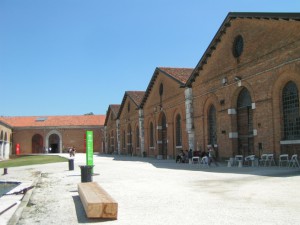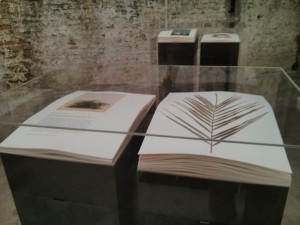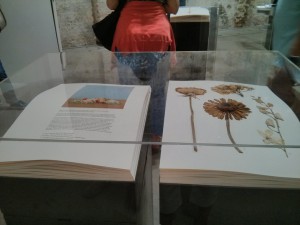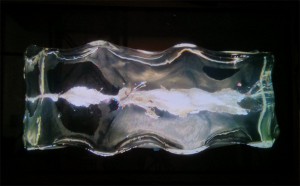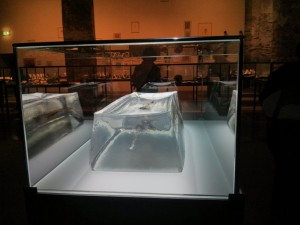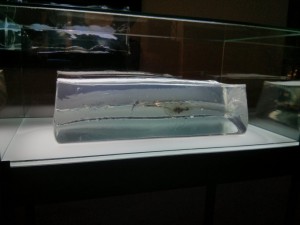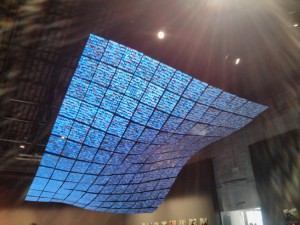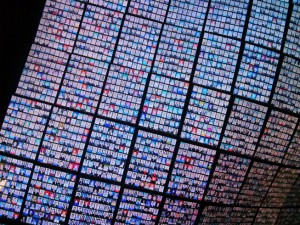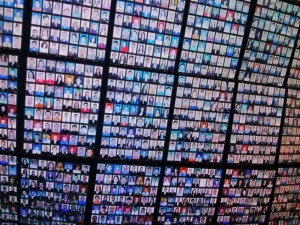The 56th Biennale di Venezia under the theme “All the World Futures” curated by Okwui Enwezor closed its doors the 22nd November 2015. Nevertheless, we will continue to reflect about the offered artworks. Since the heart of the central exhibition was the reading of “Das Kapital” by Karl Marx, we focus on the artistic approach with special attention on this subject. In the first article we presented artworks which dealt with working conditions. This part will show an approach on a more theoretical level.
Taryn Simon: “Paperwork and the will of Capital” – How the capitalist world order is presenting itself
On view in the Arsenale was “Paperwork and the will of Capital: An Account of Flora as Witness” by Taryn Simon. Several display cases showed sheets of papers with pressed flowers, besides a photo of a bouquet with these very same flowers and an explanation of the international meeting which was decorated by these plants. The choice of the treaties and governmental agreements is based on the 44 countries that participated at the conference of Bretton Woods in 1944. This summit leads to the foundation of the International Monetary Fund (IMF) and the World Bank. Afterwards there were other international reunions with resulting contracts, always decorated with flowers. In general these treaties witness the will of powerful men and the institutions they represent, to influence the financial order.
For the reconstruction of the bouquets Simon consulted the archives and ordered the corresponding flowers from the Aalsmeer Flower Auction in the Netherlands. It is the world’s biggest trading location for flowers. The huge range of different species made it possible to rearrange the “impossible bouquets”. The artist has chosen this term, because often they were composed of flowers which are not growing at the same time and in different regions of the world. Moreover the Aalsmeer Flower Auction stands for the globalised capitalist market. Additionally the “impossible bouquets” refer to the Dutch still life paintings, developed in the 17th century due to the country’s economic boom and the improvement of modern capitalism.
The flower arrangements – on the first view innocent witnesses – are changing their role to tools of political meaning: they are “coopted as forms of propaganda in the interest of political and economic gain.” (https://espionart.wordpress.com/2015/06/16/venice-biennale-highlight-2-paperwork-and-the-will-of-capital/)
Simon targeted the impact of the capitalistic system on politics and economics. Whereas the work of the Propeller Group is based on the conflict between the two opposed ideological systems from east and west.
The Propeller Group: “The Ak47 vs The M16” – Confrontation of two opposing systems
It is a quasi natural subject of the Vietnamese-American artist collective “The Propeller Group” (Tuan Andrew Nguyen, Phunam and Matt Lucero) to the exchange about capitalism and communism. They create ambitious art projects in visual art, film and video. For this year’s Biennale their researches focused the collision of the bullets from an Ak47 (Kalashnikov) and a M16. Both weapons were used during the Vietnam War and further more in the Cold War. Produced in the Ex-Soviet Union (Ak47) and the United States (M16) they symbolise – through their history – the clash between the two competing systems.
For “The Ak47 vs The M16” The Propeller Group first planned an impact and fusion of the two bullets in open air. Since this is difficult they used ballistic gel blocks and got about 21 collisions recorded by high speed cameras. In the Biennale exhibition in the Arsenal there was one of these gel blocks presented, accompanied by photos and a video. So this was only a small part of the project. Other gel blocks, photos and recordings were shown at Grand Arts, Kansas City in August and September of this year.
In an interview with ArtAsiaPacific (http://artasiapacific.com/Blog/PlayingWithGunsAndBallisticsGel) Matt Lucero of the artist collective explained the background and his feelings of the project. The first time he saw a collision he thought of the Big Bang theory, the creation of the universe. So it’s a mythical moment that hints to the future. However, the starting point of the project was to reflect about the historical moment of the opposing systems. In addition the artists wanted to hint to the present and reveal the current ideas of the historical construction of two rivalling sides.
Without this background the discovery of the gel block and the enclosed traces is fascinating and poetic. With the knowledge about what is really to be seen it makes visible how these weapons impact in the human body. However the fusion of the bullets is in life highly unlikely. Only with technical devices it was achievable to make the invisible visible. There is the frozen moment of the humanly unattainable, which might symbolise as well the stalemate that happened during the cold war at some points.
Moreover Lucero’s feelings about the Big Bang could lead to see the fusion of the bullets coming out of competing weapons as the merging of two different societies to a new one. Besides it might be read as well as the figurative expression to Marx’ dialectic, where theses and antithesis build in their confrontation a new synthesis.
Whereas Kutlug Altaman already assumes the new historical situation.
Kutlug Ataman: “The Portrait of Sakip Sabanci” – Another view on a Capitalist Player
He seems not to believe in the “dichotomy of fighting forces, but in cooperation”, he said in an interview with the Biennale Mediacenter. Instead of remaining in the old paradigm of left and right, socialist and capitalist, we should rethink these issues. (http://labiennale.org/en/mediacenter/video/56-47.html)
Ataman illustrated that point of view in “The portrait of Sakip Sabanci” (2014). It was commissioned by the family of this prominent Turkish business tycoon, on the occasion of the tenth anniversary of his death. After a reflection about leadership and what makes a man influential, he found a solution in his artistic language. For him it was important to point on the entirety, which is constructed out of many parts and actions, not to show only the head of a capitalist enterprise.
Sakip Sabanci might be a good example, for the overcoming of traditional opposites. He was not only a mayor industrialist, but strongly engaged in social and cultural activities. He founded health, education and cultural centres all over Turkey, which are still run by the 1974 created foundation. For that, he earned a lot of recognition in his native country.
Ataman created a huge multi image work, composed out of nearly 10.000 LCD panels. On view were around 30.000 individuals, all people who were somehow connected to Sabanci: workers of the factories, drivers, pupils and family members. All in all people who supported him or who were supported by him, but there is no single image that portrayed himself.
All these illuminated images are floating as a huge wave over the heads of the visitors. When one picture fades away slowly, another one appears at its place. So it is possible to represent all these people even in a limited space. They have their place in the creation of the Sabanci Lifetime Achievement, without them it wouldn’t have been possible. Such a perception of cooperation might build the base for a new society.
Adrian Piper reflects as well about new forms of societal cohabitation. Inter alia we will present her “Probable Trust Registry” in the next part about the Biennale 2015.

